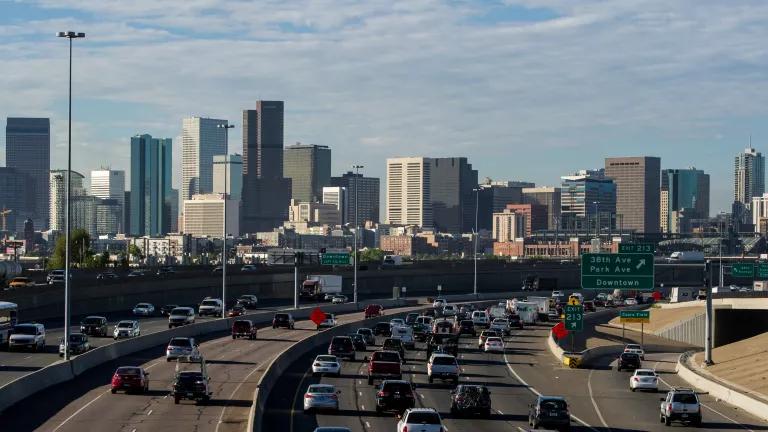Setting the Facts Straight on the DOT’s Greenhouse Gas Rule
A CRA resolution against the measure is based on a number of unfounded myths.

Interstate 5 in Seattle, Washington
Wonderlane via Flickr, CC BY-NC 4.0
The U.S. Department of Transportation (DOT) is facing its first major legislative challenge for its greenhouse gas (GHG) performance measure rule with the recent introduction of a joint Congressional Review Act (CRA) resolution, led by Senator Kevin Cramer and Congressman Rick Crawford. The resolution would nullify the rule and prevent the DOT from moving forward with implementation.
The DOT is using its statutory authority to have states measure and set targets to reduce the greenhouse gas impacts of their transportation investments. This measure is basic good governance and will help to create equitable and accessible transportation systems for all.
The latest attack comes as no surprise; Republicans have been taking pot shots at the rule since it came out. Two lawsuits, led by attorneys general in Kentucky and Texas, have already been filed in opposition to the rule. Kentucky’s suit includes 20 other states. The DOT initially delayed the deadline for states to submit their targets by 45 days in response to the lawsuits. Now the agency has established a period of non-implementation for the rule through March 29, and while states are free to move forward with submitting their targets, there will be no action from the DOT until the end of March.
Arguments used in the joint resolution to fight this commonsense rule are thin. Here are the facts:
False claim #1: This is a one-size-fits-all regulation. Not true. States have significant flexibility in how they implement the rule. The rule asks states and Metropolitan Planning Organizations to set targets based on their specific transportation, economic, and demographic contexts. There is no minimum reduction target that they must meet nor are there any repercussions for failing to meet submitted targets. States are not going to suddenly lose access to federal sources of transportation funding as a result of the requirements in this rule, and they can continue to use a wide array of policy levers to meet those targets and create transportation systems that serve the needs of their constituents. No one expects the transpotation systems in North Dakota and New York to look the same. This rule is flexible enough to accommodate the needs of both states, and everywhere in between.
False claim #2: The administration does not have the authority to impose GHG emissions performance measures on state DOTs without additional congressional direction. There is no doubt that the DOT already has authority to require that states set targets and track greenhouse gas emissions as part of the National Highway Performance Program (NHPP). The NHPP’s mandate is to establish a national highway performance program that includes performance measures and standards. Additionally, the NHPP provides support for activities that improve the resiliency of the National Highway System against sea level rise, extreme weather events, flooding, wildfires, or other natural disasters, all of which are directly related to climate change.
False claim #3: This rule will cause serious damage to state economies. This rule creates transparency around how states are spending their transportation dollars—something that is increasingly important in the context of the historic new investments from the Bipartisan Infrastructure Law and the Inflation Reduction Act. Tracking GHG emissions from transportation will give states a baseline from which to assess the environmental performance of their highways moving forward. Additionally, it can help them direct the flow of dollars toward projects that have proven economic and community benefits, including deployment of light- and heavy-duty electric vehicles, electric vehicle charging infrastructure, transit-oriented development, and new bicycle and pedestrian infrastructure. Far from causing harm to states’ economies, these investments have been shown to improve safety, livability, and economic development in communities. Lastly, compliance costs associated with the rule are projected to be minimal. Many states already have the tools they need to set targets and track progress.
Support for the rule isn’t in doubt. As a follow-up to a letter submitted to the DOT by a group of states expressing support for the rule, several states have already submitted targets, moving forward with implementation of the rule despite legal holdups and now this resolution. This includes the state of Maryland, which has set a target to reduce emissions from its sections of the National Highway System by 4 percent by the end of 2025 from a 2022 baseline. More than 90 organizations signed a letter of support for the measure, including those in the environmental community, private businesses, local transit groups, faith-based organizations, accessibility coalitions, and justice-focused organizations. Supporters recognize that requiring states to track the climate impacts of their federal transportation dollars is necessary for creating equitable and accessible transportation systems.



